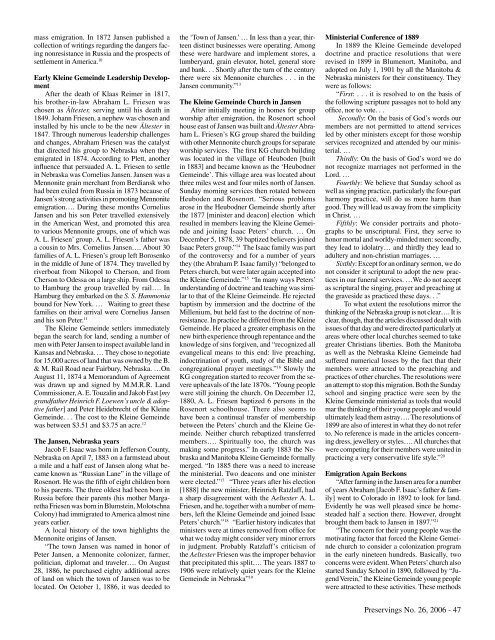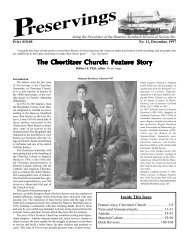Preservings $20 Issue No. 26, 2006 - Home at Plett Foundation
Preservings $20 Issue No. 26, 2006 - Home at Plett Foundation
Preservings $20 Issue No. 26, 2006 - Home at Plett Foundation
Create successful ePaper yourself
Turn your PDF publications into a flip-book with our unique Google optimized e-Paper software.
mass emigr<strong>at</strong>ion. In 1872 Jansen published a<br />
collection of writings regarding the dangers facing<br />
nonresistance in Russia and the prospects of<br />
settlement in America. 10<br />
Early Kleine Gemeinde Leadership Development<br />
After the de<strong>at</strong>h of Klaas Reimer in 1817,<br />
his brother-in-law Abraham L. Friesen was<br />
chosen as Ältester, serving until his de<strong>at</strong>h in<br />
1849. Johann Friesen, a nephew was chosen and<br />
installed by his uncle to be the new Ältester in<br />
1847. Through numerous leadership challenges<br />
and changes, Abraham Friesen was the c<strong>at</strong>alyst<br />
th<strong>at</strong> directed his group to Nebraska when they<br />
emigr<strong>at</strong>ed in 1874. According to <strong>Plett</strong>, another<br />
influence th<strong>at</strong> persuaded A. L. Friesen to settle<br />
in Nebraska was Cornelius Jansen. Jansen was a<br />
Mennonite grain merchant from Berdiansk who<br />
had been exiled from Russia in 1873 because of<br />
Jansen’s strong activities in promoting Mennonite<br />
emigr<strong>at</strong>ion…. During these months Cornelius<br />
Jansen and his son Peter travelled extensively<br />
in the American West, and promoted this area<br />
to various Mennonite groups, one of which was<br />
A. L. Friesen’ group. A. L. Friesen’s f<strong>at</strong>her was<br />
a cousin to Mrs. Cornelius Jansen…. About 30<br />
families of A. L. Friesen’s group left Borosenko<br />
in the middle of June of 1874. They travelled by<br />
riverbo<strong>at</strong> from Nikopol to Cherson, and from<br />
Cherson to Odessa on a large ship. From Odessa<br />
to Hamburg the group travelled by rail…. In<br />
Hamburg they embarked on the S. S. Hammonia<br />
bound for New York. … Waiting to greet these<br />
families on their arrival were Cornelius Jansen<br />
and his son Peter. 11<br />
The Kleine Gemeinde settlers immedi<strong>at</strong>ely<br />
began the search for land, sending a number of<br />
men with Peter Jansen to inspect available land in<br />
Kansas and Nebraska. … They chose to negoti<strong>at</strong>e<br />
for 15,000 acres of land th<strong>at</strong> was owned by the B.<br />
& M. Rail Road near Fairbury, Nebraska. …On<br />
August 11, 1874 a Memorandum of Agreement<br />
was drawn up and signed by M.M.R.R. Land<br />
Commissioner, A. E. Touzalin and Jakob Fast [my<br />
grandf<strong>at</strong>her Heinrich F. Loewen’s uncle & adoptive<br />
f<strong>at</strong>her] and Peter Heidebrecht of the Kleine<br />
Gemeinde. . . The cost to the Kleine Gemeinde<br />
was between $3.51 and $3.75 an acre. 12<br />
The Jansen, Nebraska years<br />
Jacob F. Isaac was born in Jefferson County,<br />
Nebraska on April 7, 1883 on a farmstead about<br />
a mile and a half east of Jansen along wh<strong>at</strong> became<br />
known as “Russian Lane” in the village of<br />
Rosenort. He was the fifth of eight children born<br />
to his parents. The three oldest had been born in<br />
Russia before their parents (his mother Margaretha<br />
Friesen was born in Blumstein, Molotschna<br />
Colony) had immigr<strong>at</strong>ed to America almost nine<br />
years earlier.<br />
A local history of the town highlights the<br />
Mennonite origins of Jansen.<br />
“The town Jansen was named in honor of<br />
Peter Jansen, a Mennonite colonizer, farmer,<br />
politician, diplom<strong>at</strong> and traveler…. On August<br />
28, 1886, he purchased eighty additional acres<br />
of land on which the town of Jansen was to be<br />
loc<strong>at</strong>ed. On October 1, 1886, it was deeded to<br />
the ‘Town of Jansen.’ … In less than a year, thirteen<br />
distinct businesses were oper<strong>at</strong>ing. Among<br />
these were hardware and implement stores, a<br />
lumberyard, grain elev<strong>at</strong>or, hotel, general store<br />
and bank. . . Shortly after the turn of the century<br />
there were six Mennonite churches . . . in the<br />
Jansen community.” 13<br />
The Kleine Gemeinde Church in Jansen<br />
After initially meeting in homes for group<br />
worship after emigr<strong>at</strong>ion, the Rosenort school<br />
house east of Jansen was built and Ältester Abraham<br />
L. Friesen’s KG group shared the building<br />
with other Mennonite church groups for separ<strong>at</strong>e<br />
worship services. The first KG church building<br />
was loc<strong>at</strong>ed in the village of Heuboden [built<br />
in 1883] and became known as the ‘Heubodner<br />
Gemeinde’. This village area was loc<strong>at</strong>ed about<br />
three miles west and four miles north of Jansen.<br />
Sunday morning services then rot<strong>at</strong>ed between<br />
Heuboden and Rosenort. “Serious problems<br />
arose in the Heubodner Gemeinde shortly after<br />
the 1877 [minister and deacon] election which<br />
resulted in members leaving the Kleine Gemeinde<br />
and joining Isaac Peters’ church. … On<br />
December 5, 1878, 39 baptized believers joined<br />
Isaac Peters group.” 14 The Isaac family was part<br />
of the controversy and for a number of years<br />
they (the Abraham P. Isaac family) “belonged to<br />
Peters church, but were l<strong>at</strong>er again accepted into<br />
the Kleine Gemeinde.” 15 “In many ways Peters’<br />
understanding of doctrine and teaching was similar<br />
to th<strong>at</strong> of the Kleine Geimeinde. He rejected<br />
baptism by immersion and the doctrine of the<br />
Millenium, but held fast to the doctrine of nonresistance.<br />
In practice he differed from the Kleine<br />
Gemeinde. He placed a gre<strong>at</strong>er emphasis on the<br />
new birth experience through repentance and the<br />
knowledge of sins forgiven, and “recognized all<br />
evangelical means to this end: live preaching,<br />
indoctrin<strong>at</strong>ion of youth, study of the Bible and<br />
congreg<strong>at</strong>ional prayer meetings.” 16 Slowly the<br />
KG congreg<strong>at</strong>ion started to recover from the severe<br />
upheavals of the l<strong>at</strong>e 1870s. “Young people<br />
were still joining the church. On December 12,<br />
1880, A. L. Friesen baptized 6 persons in the<br />
Rosenort schoolhouse. There also seems to<br />
have been a continual transfer of membership<br />
between the Peters’ church and the Kleine Gemeinde.<br />
Neither church rebaptized transferred<br />
members…. Spiritually too, the church was<br />
making some progress.” In early 1883 the Nebraska<br />
and Manitoba Kleine Gemeinde formally<br />
merged. “In 1885 there was a need to increase<br />
the ministerial. Two deacons and one minister<br />
were elected.” 17 “Three years after his election<br />
[1888] the new minister, Heinrich R<strong>at</strong>zlaff, had<br />
a sharp disagreement with the Aeltester A. L.<br />
Friesen, and he, together with a number of members,<br />
left the Kleine Gemeinde and joined Isaac<br />
Peters’ church.” 18 “Earlier history indic<strong>at</strong>es th<strong>at</strong><br />
ministers were <strong>at</strong> times removed from office for<br />
wh<strong>at</strong> we today might consider very minor errors<br />
in judgment. Probably R<strong>at</strong>zlaff’s criticism of<br />
the Aeltester Friesen was the improper behavior<br />
th<strong>at</strong> precipit<strong>at</strong>ed this split…. The years 1887 to<br />
1906 were rel<strong>at</strong>ively quiet years for the Kleine<br />
Gemeinde in Nebraska” 19<br />
Ministerial Conference of 1889<br />
In 1889 the Kleine Gemeinde developed<br />
doctrine and practice resolutions th<strong>at</strong> were<br />
revised in 1899 in Blumenort, Manitoba, and<br />
adopted on July 1, 1901 by all the Manitoba &<br />
Nebraska ministers for their constituency. They<br />
were as follows:<br />
“First: . . . it is resolved to on the basis of<br />
the following scripture passages not to hold any<br />
office, nor to vote. . .<br />
Secondly: On the basis of God’s words our<br />
members are not permitted to <strong>at</strong>tend services<br />
led by other ministers except for those worship<br />
services recognized and <strong>at</strong>tended by our ministerial.<br />
…<br />
Thirdly: On the basis of God’s word we do<br />
not recognize marriages not performed in the<br />
Lord. …<br />
Fourthly: We believe th<strong>at</strong> Sunday school as<br />
well as singing practice, particularly the four-part<br />
harmony practice, will do us more harm than<br />
good. They will lead us away from the simplicity<br />
in Christ. …<br />
Fifthly: We consider portraits and photographs<br />
to be unscriptural. First, they serve to<br />
honor mortal and worldy-minded men: secondly,<br />
they lead to idol<strong>at</strong>ry… and thirdly they lead to<br />
adultery and non-christian marriages. …<br />
Sixthly: Except for an ordinary sermon, we do<br />
not consider it scriptural to adopt the new practices<br />
in our funeral services. …We do not accept<br />
as scriptural the singing, prayer and preaching <strong>at</strong><br />
the graveside as practiced these days. . .”<br />
To wh<strong>at</strong> extent the resolutions mirror the<br />
thinking of the Nebraska group is not clear…. It is<br />
clear, though, th<strong>at</strong> the articles discussed dealt with<br />
issues of th<strong>at</strong> day and were directed particularly <strong>at</strong><br />
areas where other local churches seemed to take<br />
gre<strong>at</strong>er Christians liberties. Both the Manitoba<br />
as well as the Nebraska Kleine Gemeinde had<br />
suffered numerical losses by the fact th<strong>at</strong> their<br />
members were <strong>at</strong>tracted to the preaching and<br />
practices of other churches. The resolutions were<br />
an <strong>at</strong>tempt to stop this migr<strong>at</strong>ion. Both the Sunday<br />
school and singing practice were seen by the<br />
Kleine Gemeinde ministerial as tools th<strong>at</strong> would<br />
mar the thinking of their young people and would<br />
ultim<strong>at</strong>ely lead them astray…. The resolutions of<br />
1899 are also of interest in wh<strong>at</strong> they do not refer<br />
to. <strong>No</strong> reference is made in the articles concerning<br />
dress, jewellery or styles…. All churches th<strong>at</strong><br />
were competing for their members were united in<br />
practicing a very conserv<strong>at</strong>ive life style.” 20<br />
Emigr<strong>at</strong>ion Again Beckons<br />
“After farming in the Jansen area for a number<br />
of years Abraham [Jacob F. Isaac’s f<strong>at</strong>her & family]<br />
went to Colorado in 1892 to look for land.<br />
Evidently he was well pleased since he homesteaded<br />
half a section there. However, drought<br />
brought them back to Jansen in 1897.” 21<br />
“The concern for their young people was the<br />
motiv<strong>at</strong>ing factor th<strong>at</strong> forced the Kleine Gemeinde<br />
church to consider a coloniz<strong>at</strong>ion program<br />
in the early nineteen hundreds. Basically, two<br />
concerns were evident. When Peters’ church also<br />
started Sunday School in 1890, followed by “Jugend<br />
Verein,” the Kleine Gemeinde young people<br />
were <strong>at</strong>tracted to these activities. These methods<br />
<strong>Preservings</strong> <strong>No</strong>. <strong>26</strong>, <strong>2006</strong> - 47
















